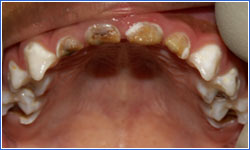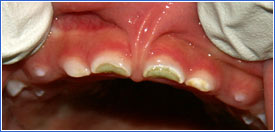What is ECC?
Early Childhood Caries (ECC) is a chronic disease that destroys tooth structure leading to loss of chewing function, pain, and infection in children through five years of age. Defined as > 1 decayed, missing, or filled primary tooth surface in children under the age of 6.
- ECC was once called "nursing caries" or "baby bottle tooth decay."
- Now the disease is called ECC as a variety of feeding habits are implicated.
- Other known variables include socioeconomic status, access to dental care, fluoride exposure, and family caries experience.
Caries Prevalence
- 21% of primary teeth ages 2-5
- 51% of permanent teeth ages 6-11
- 54% adolescents ages 12-19
Progression
- Upper front teeth that are least protected by saliva are affected first
- Disease moves posteriorly as teeth emerge
Severe Early Childhood Caries


References
Centers for Disease Control and Prevention. Oral Health Surveillance Report: Trends in Dental Caries and Sealants, Tooth Retention, and Edentulism, United States, 1999–2004 to 2011–2016. Atlanta, GA: Centers for Disease Control and Prevention, US Dept of Health and Human Services; 2019. www.cdc.gov/oralhealth/publications/OHSR-2019-dental-caries-permanent-teeth.html
American Academy of Pediatric Dentistry. Policy on early childhood caries (ECC): Consequences and preventive strategies. The Reference Manual of Pediatric Dentistry. Chicago, Ill.: American Academy of Pediatric Dentistry; 2023: 88-91.
Dye BA, Xianfen L, Beltrán-Aguilar ED. Selected Oral Health Indicators in the United States 2005–2008. NCHS Data Brief, no. 96. Hyattsville, MD: National Center for Health Statistics, Centers for Disease Control and Prevention; 2012.
Fleming E, Afful J. Prevalence of total and untreated dental caries among youth: United States, 2015–2016. NCHS Data Brief, no 307. Hyattsville, MD: National Center for Health Statistics. 2018.
Wright JT. The Burden and Management of Dental Caries in Older Children. Pediatr Clin North Am. 2018; 65(5): 955-963.